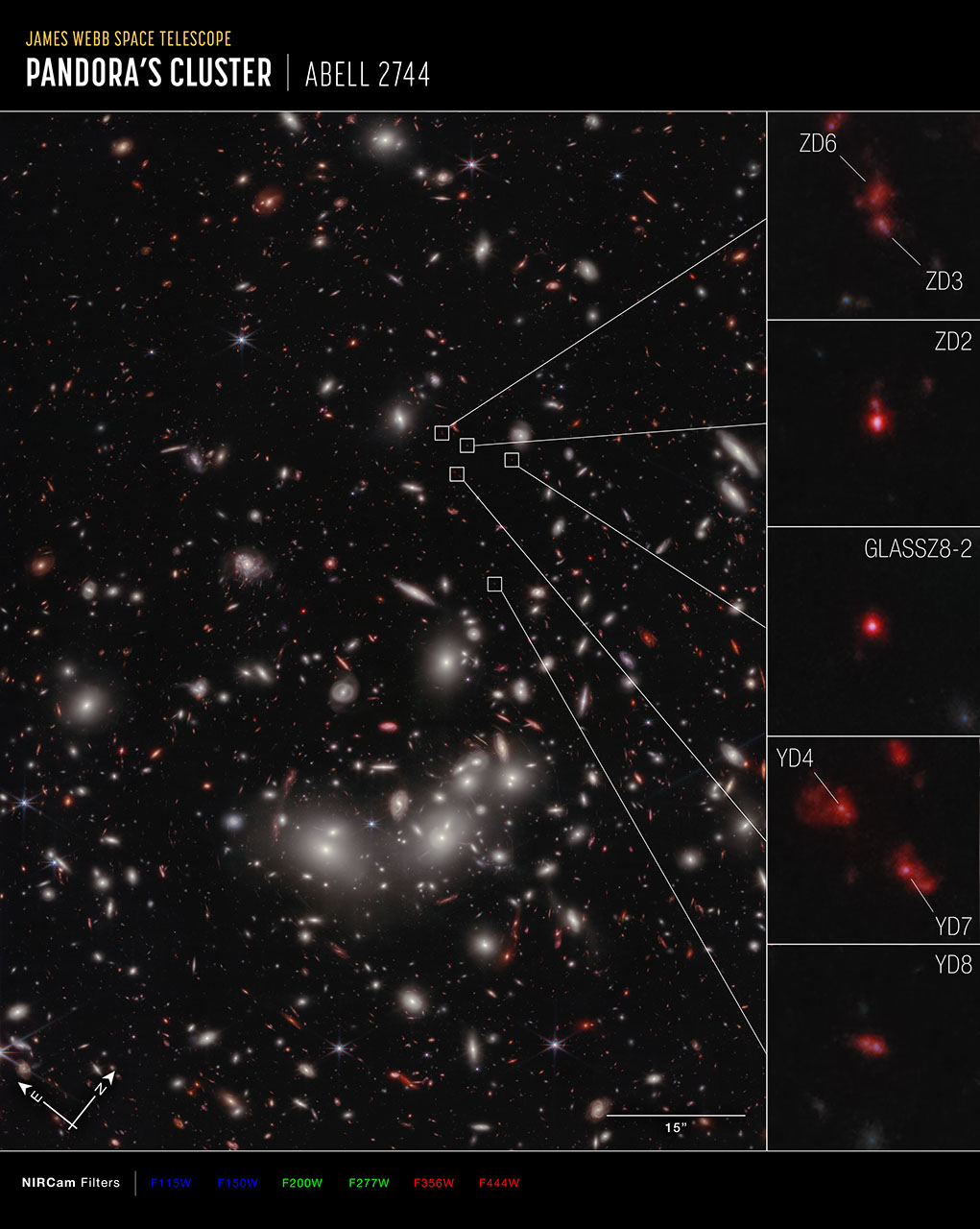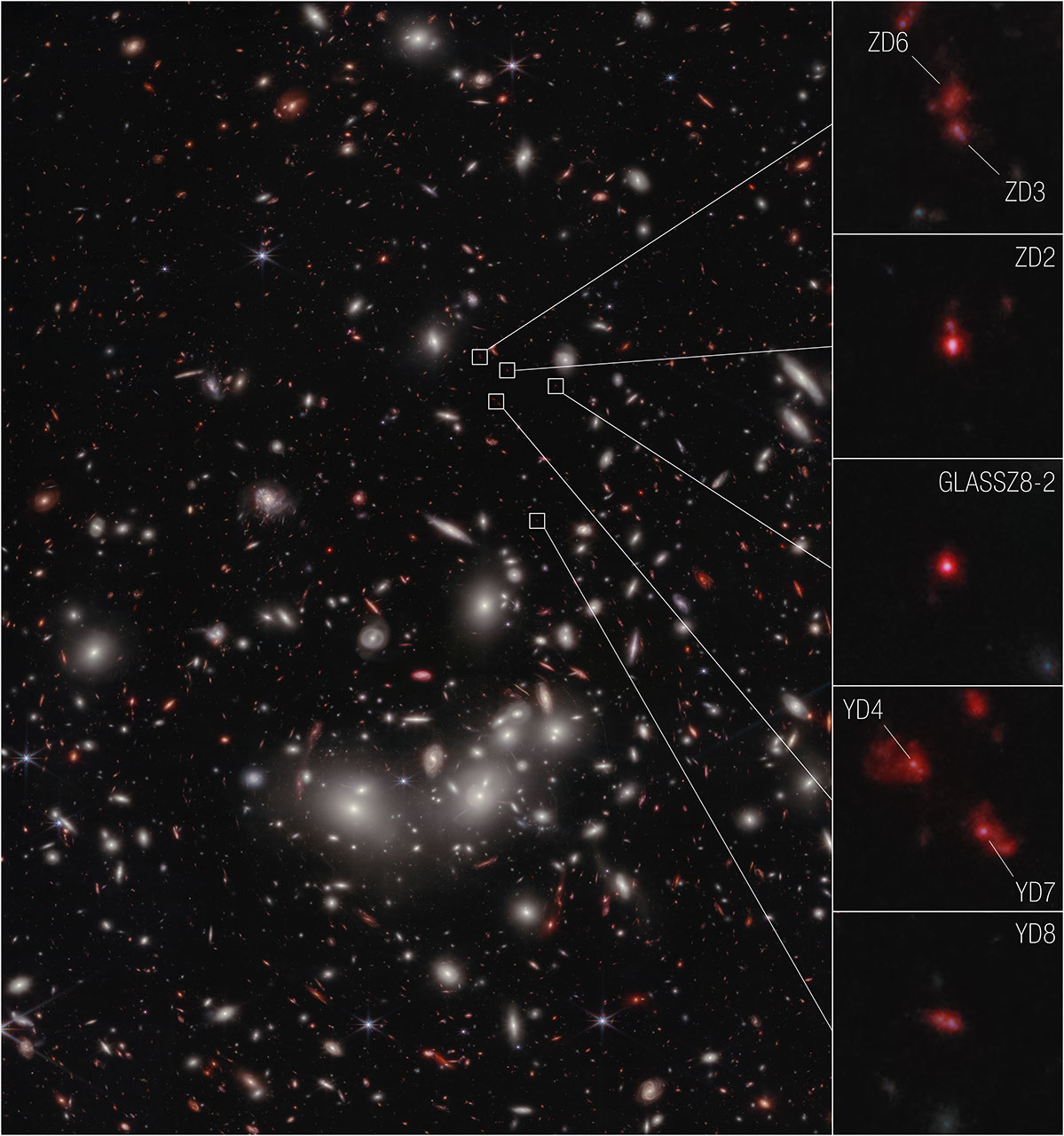1 min read
Galaxy Protocluster (NIRCam Compass Image)

Image of a distant galaxy protocluster in the early universe, captured by the Near-Infrared Camera (NIRCam) on NASA’s James Webb Space Telescope, with compass arrows, scale bar, and color key for reference.
The north and east compass arrows show the orientation of the image on the sky. Note that the relationship between north and east on the sky (as seen from below) is flipped relative to direction arrows on a map of the ground (as seen from above).
The scale bar is labeled in arc seconds, which is a measure of angular distance on the sky. One arc second is equal to 1/3600 of one degree of arc. (The full Moon has an angular diameter of about 0.5 degrees.) The actual size of an object that covers one arc second on the sky depends on its distance from the telescope.
The color key shows the NIRCam filters used. The color of each filter name is the visible light color used to represent the infrared light that passed through that filter.
About the Object
- R.A. PositionR.A. PositionRight ascension – analogous to longitude – is one component of an object's position.00:14:18.25
- Dec. PositionDec. PositionDeclination – analogous to latitude – is one component of an object's position.-30:22:46.04
- ConstellationConstellationOne of 88 recognized regions of the celestial sphere in which the object appears.Sculptor
- DistanceDistanceThe physical distance from Earth to the astronomical object. Distances within our solar system are usually measured in Astronomical Units (AU). Distances between stars are usually measured in light-years. Interstellar distances can also be measured in parsecs.3.5 billion light-years to main cluster
About the Data
- Data DescriptionData DescriptionProposal: A description of the observations, their scientific justification, and the links to the data available in the science archive.
Science Team: The astronomers who planned the observations and analyzed the data. "PI" refers to the Principal Investigator.This image was created with Webb data from proposal: 2561 (I. Labbe).
- InstrumentInstrumentThe science instrument used to produce the data.NIRCam
- Exposure DatesExposure DatesThe date(s) that the telescope made its observations and the total exposure time.2 Nov 2022, 15 Nov 2022
- FiltersFiltersThe camera filters that were used in the science observations.F115W, F150W, F200W, F277W, F356W, F444W
- Object NameObject NameA name or catalog number that astronomers use to identify an astronomical object.Pandora's Cluster, Abell 2744
- Object DescriptionObject DescriptionThe type of astronomical object.Galaxy Cluster and Gravitational Lens
- Release DateApril 24, 2023
- Science ReleaseWebb Reveals Early-Universe Prequel to Huge Galaxy Cluster
- CreditImage: NASA, ESA, CSA, Takahiro Morishita (Caltech/IPAC); Image Processing: Alyssa Pagan (STScI)

These images are a composite of separate exposures acquired by the James Webb Space Telescope using the NIRCam instrument. Several filters were used to sample specific wavelength ranges. The color results from assigning different hues (colors) to each monochromatic (grayscale) image associated with an individual filter. In this case, the assigned colors are: Blue: F115W+F150W, Green: F200W+F277W, Red: F356W+F444W
Related Images & Videos

Galaxy Protocluster (NIRCam Image)
The seven galaxies highlighted in this James Webb Space Telescope image have been confirmed to be at a distance that astronomers refer to as redshift 7.9, which correlates to 650 million years after the big bang. This makes them the earliest galaxies yet to be spectroscopically...
Share
Details
Laura Betz
NASA’s Goddard Space Flight Center
Greenbelt, Maryland
laura.e.betz@nasa.gov
NASA, ESA, CSA, Takahiro Morishita (Caltech/IPAC)
Alyssa Pagan (STScI)






























